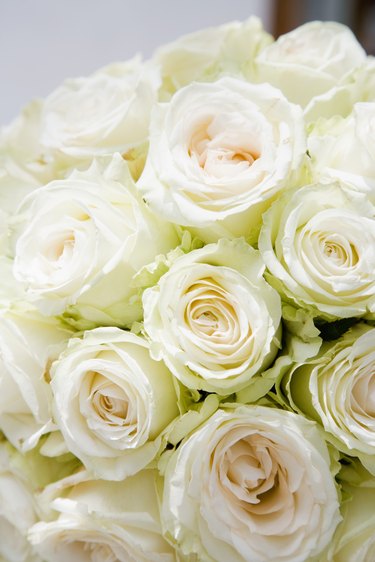Things You'll Need
Cream-colored roses with the buds still tight
Low-salt plant dye or food coloring
Hypodermic needles
Vase

Dyeing flowers and roses has long been a favorite way for florists to draw attention to unusual specimens. It can also be an interesting science project, which helps students understand the vascular system of plants, as well as a way to preserve plants that tend to fade when they are dried. Most people simply add food coloring to the water of cut flowers. When this is done, the plant draws the dye through its stems, which changes the color of the flowers; however, many people fantasize about changing the color of living flowers. References to injecting flowers with dye date back to the 12th century Islamic texts, in which there are a few references to using needles to inject dye into living plants to change the color of flowers of living and growing plants, a method recently perfected for the "Blue Mystique" orchid. Many contemporary methods, however, are proprietary and patented. They may also kill the plants. For this reason, two methods for dyeing flowers are presented -- a risky and experimental one using hypodermic injections, and a common one using food coloring.
Injecting Your Plant
Step 1
Choose a dye that is based on natural products and is low in salts to lessen the risk of toxicity to the plant. Prepare dye according to the manufacturer's instructions. Dip the tip of the syringe in the dye and pull the plunger up to draw in the dye.
Video of the Day
Step 2
Locate places to inject the plant with the needle. Select areas where the stem is soft and able to be pierced with the needle. Water in a plant travels from the ground through the roots, up through the stem and branches and into the flowers and leaves where it evaporates. Because this path is mostly one-way, select injection sites that are very high on the stem and close to the bud. This way, if the dye turns out to be toxic to the plant, it won't kill it.
Step 3
Inject the dye directly into the tight bud, which minimizes risk to the plant. This may "marinate" the flower in dye. Doing this can give you the impression the flower has bloomed in that color -- if it doesn't kill the flower.
Step 4
Fill the needle with a very small amount of dye -- less than a milliliter. Inject the dye into the plant. Monitor for signs of death.
Injecting Cut Flowers
Step 1
Gather a bunch of cut flowers. White flowers work best and are easiest to dye.
Step 2
Fill a vase with water.
Step 3
Add pure food coloring or dye.
Step 4
Place the flowers in the vase. The flowers should change colors in 12 to 24 hours.
Step 5
Experiment to create dazzling displays by splitting the stem across its length. Dip each half in a different color dye to create a flower with more than one color.
Tip
Many people believe the famous "rainbow roses" developed in 2007 by a Dutch company are the result of injections. This is false. Rainbow roses, according to Chronica Horticulturae, the Journal of the International Society for Horticulture Science, are made by splitting the stem down its length in four parts and dipping each quarter into a cup filled with dye. The process is quite difficult. The company that invented this has said it took six months to get the technique right.
A 12th century text by Zubair ibn al-Awam references a method to make blue roses, either by adding die to the soil or bark. A French scientist named Joret purportedly replicated this method in the 19th century. It is unclear if any English translation of this feat exists; other accounts call Joret's feats unreliable.
Video of the Day
- Home and Garden Ideas: How to Make Tie Dye Roses
- University of Illinois Department of Physics: Q & A: Food Coloring and Plants
- "Chronica Horticulturae": Gilding the Lilies: Rainbow Roses and Confetti Poinsettias
- Snopes.com: Rainbow Roses
- Longwood Gardens: How Did They Do That? Blue Dyed Orchid Display
- Youtube: Plant Necrosis After Red Food Coloring Injection
- "Roses"; The Blue Rose